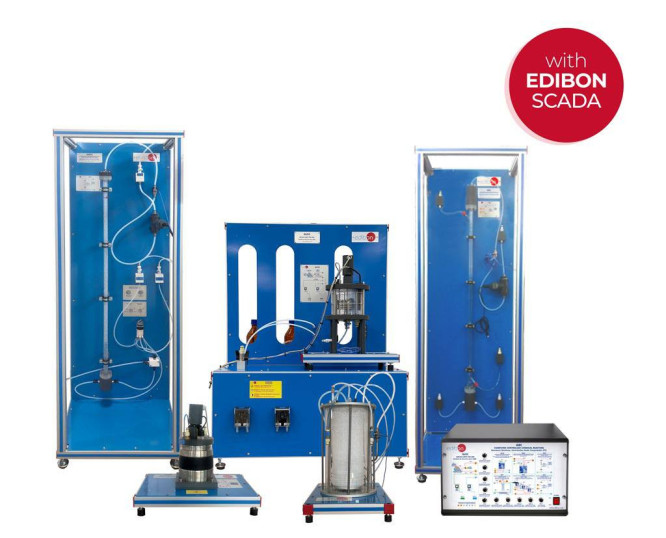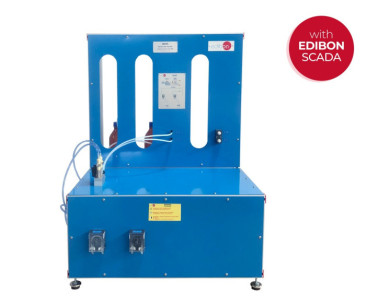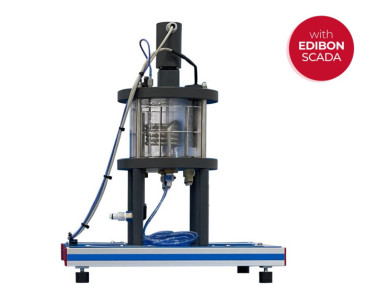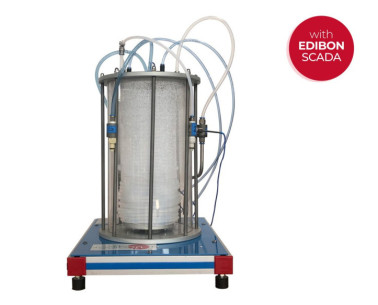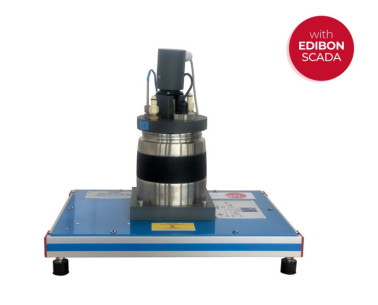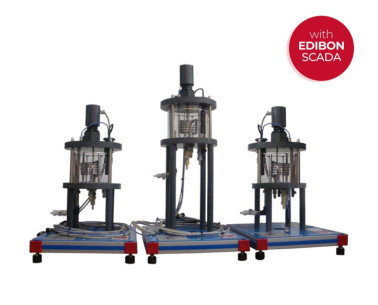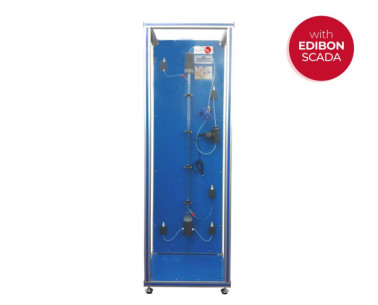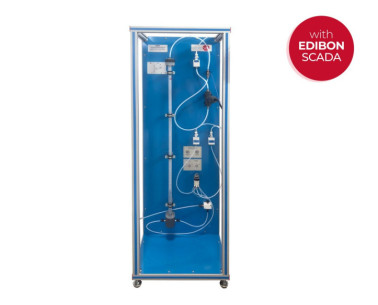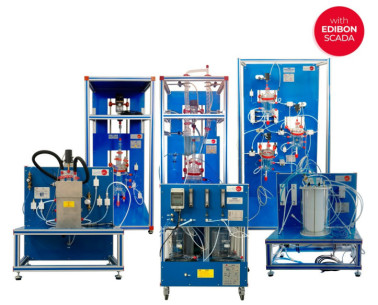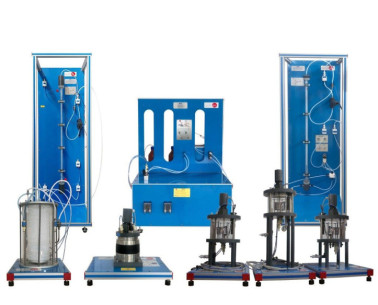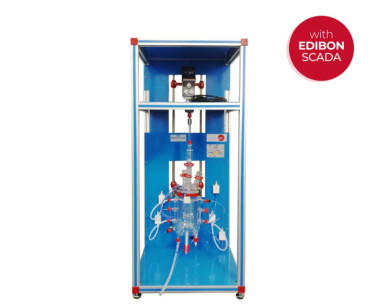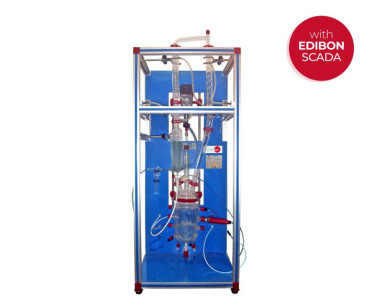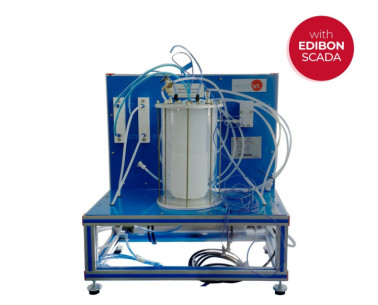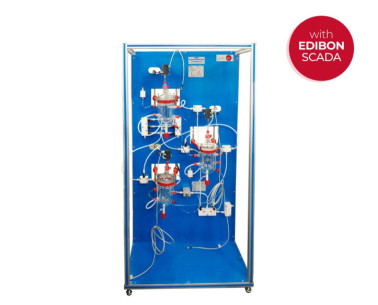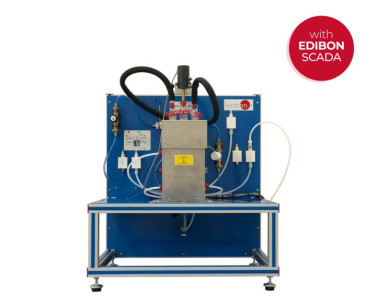QRC Reaktor Kimia, Dikendalikan dari Komputer (PC)
SISTEM INOVATIF
The Computer Controlled Chemical Reactors, "QRC", has been designed by EDIBON for the study and comparison of different types of chemical reactors in an easy and simple way and thus allowing, on a small scale, to carry out the necessary studies and practices to understand the operation of the reactors.
Laboratorium
BERITA TERKAIT
GAMBARAN UMUM
The Computer Controlled Chemical Reactors, "QRC", has been designed by EDIBON for the study and comparison of different types of chemical reactors in an easy and simple way and thus allowing, on a small scale, to carry out the necessary studies and practices to understand the operation of the reactors.
These reactors allow for the comparison of different types of chemical reactors, and with each type of reactor, the study of the influence of reaction temperature and residence time is enabled, thanks to the thermostatic bath, two 1 l tanks, and two regulation pumps of up to 3 l/min included in the supply.
The Service Unit for QRC, "QUSC", provides the necessary elements for the operation of the different reactor modules. It performs the following functions:
- Reagent supply: consisting of two 1 l pyrex containers each located at the back, two dosing pumps and all the necessary connections.
- Temperature control: consisting of a thermostatic bath and an impulsion pump.
- Quick and easy to perform reactor exchange and positioning system.
- This unit allows feeding reagents and temperature control of reactors with a volume up to 1.5 l.
These Computer Controlled Units are supplied with EDIBON Computer Control System (SCADA), and includes: The unit itself + a Control Interface Box + a Data Acquisition Board + Computer Control, Data Acquisition and Data Management Software Packages, for controlling the process and all parameters involved in the process.
Aksesoris
Reaktor Tangki Pengaduk Kontinu untuk QRC, Dikendalikan dari Komputer (PC)
Reaktor Aliran Pipa untuk QRC, Dikendalikan dari Komputer (PC)
Reaktor Diskontinu untuk QRC, Dikendalikan dari Komputer (PC)
Reaktor Tangki Pengaduk Seri untuk QRC, Dikendalikan dari Komputer (PC)
Reaktor Aliran Laminar untuk QRC, Dikendalikan dari Komputer (PC)
Reaktor Aliran Piston untuk QRC, Dikendalikan dari Komputer (PC)
LATIHAN DAN PRAKTEK PEDOMAN
LATIHAN PRAKTIS YANG DIANDAL TERMASUK DALAM PANDUAN
Practices to be done with the Continuous Stirred Tank Reactor (QRCAC):
- Determination of the ionic conductivities.
- Batch operation. Obtaining of the reaction order respect to ethylacetate. Initial velocity method.
- Batch operation. Obtaining of the reaction order respect to sodium hydroxide. Initial velocity method.
- Batch operation. Velocity Constant Computation. Constant sodium hydroxide initial concentration.
- Batch operation. Velocity Constant Computation. Constant ethylacetate initial concentration.
- Velocity equation formulation.
- Batch operation. Variation of the kinetic constant with temperature. Arrhenius Equation.
- Batch operation. Theoretical and experimental conversion comparative. Deviation from ideality.
- Batch operation. Mixture effects.
- Continuous operation.
- Continuous operation. Mixture effects.
- Conductivity measurement system: conductimeter.
- Variation of conversion with residence time.
- Residence time distribution.
- Determination of the reaction rate constant.
- Sensors calibration.
Practices to be done with the Tubular Flow Reactor (QRTC):
- Analysis of reagents and products.
- Ionic conductivities determination.
- Theoretical conversion of the tubular reactor.
- Experimental determination of the conversion of the tubular reactor.
- Dependence of the residence time.
- Determination of the reaction order.
- Dependence of the speed constant and the conversion with the temperature.
- Conductivity measurement system: conductimeter.
- Complete emptying of the unit.
- Determination of the reaction rate constant.
- Sensors calibration.
Practices to be done with the Batch Reactor (QRDC):
- Determination of the ionic conductivities.
- Batch operation. Calculation of the order of the reaction referred to the ethyl-acetate. Initial velocity method.
- Batch operation. Determination of the order of the reaction referred to the sodium hydroxide. Initial velocity method.
- Batch operation. Determination of the speed constant, the initial concentration of the sodium hydroxide is constant.
- Batch operation. Determination of the speed constant, the initial concentration of the ethyl acetate is constant.
- Formulation of the speed equation.
- Batch operation. Variation of the kinetic constant when the temperature is not constant: Arrhenius equation.
- Batch operation. Comparison of the theoretical and the experimental conversion: Deviation from the ideality.
- Calculation of the heat transference coefficient of the coil.
- Calculation of the hydrolysis reaction enthalpy.
- Batch operation. Mixture effects.
- Conductivity measurement system: conductimeter.
- Sensors calibration.
Practices to be done with Stirred Tank Reactors in Series (QRSC):
- Investigation of dynamic behaviour of stirred tank reactors in series.
- Determination of the ionic conductivities.
- Influence of flow rate.
- Work with just one reactor in continuous.
- Work with just one reactor in continuous with mixture effects.
- Work with 3 reactors in continuous.
- Effect of step input change.
- Response to an impulse change.
- Investigation of time constant using dead time coil.
- Sensors calibration.
Practices to be done with the Laminar Flow Reactor (QRLC):
- Determination of the residence time distribution of the reactor.
- Effect of flow rate and feed concentration on the determination of flow pattern.
- Steady state conversion for a reaction with laminar flow.
- Effect of flow rate and feed concentration on the steady state conversion.
- Demonstration of the flow pattern in the reactor and comparison with the theoretical model.
- Effect of the temperature on the laminar flow characterisation.
- Determination of the steady state conversion of a second order reaction.
- Flow pattern characterisation in a laminar flow reactor.
- Conductivity measurement system: conductimeter.
- Sensors calibration.
Practices to be done with Plug Flow Reactor (QRPC):
- Determination of the residence time distribution of the reactor.
- Effect of flow rate and feed concentration on the determination of flow pattern.
- Study of the reactor response to different perturbations: step and pulse change.
- Effect of flow rate and feed concentration on the steady state conversion.
- Demonstration of the flow pattern in the reactor and comparison with the theoretical model.
- Determination of the steady state conversion of a second order reaction.
- Understanding the principles of tracer techniques in flow pattern characterisation.
- Conductivity measurement system: conductimeter.
- Sensors calibration.
LEBIH BANYAK LATIHAN PRAKTIS YANG AKAN DILAKUKAN DENGAN UNIT
- Many students view results simultaneously. To view all results in real time in the classroom by means of a projector or an electronic whiteboard.
- Open Control, Multicontrol and Real Time Control. This unit allows intrinsically and/or extrinsically to change the span, gains, proportional, integral, derivate parameters, etc, in real time.
- The Computer Control System with SCADA and PID Control allow a real industrial simulation.
- This unit is totally safe as uses mechanical, electrical and electronic, and software safety devices.
- This unit can be used for doing applied research.
- This unit can be used for giving training courses to Industries even to other Technical Education Institutions.
- Control of the unit process through the control interface box without the computer.
- Visualization of all the sensors values used in the unit process.
- By using PLC-PI additional 19 more exercises can be done.
- Several other exercises can be done and designed by the user.
PERALATAN SIMILAR TERSEDIA
Sistem Pelatihan Reaktor Kimia, Dikendalikan dari Komputer (PC)
Reaktor Kimia
PERALATAN KOMPLEMENTER
Reaktor dengan Rekirkulasi untuk Media Korosif 20L, Dikendalikan dari Komputer (PC) dan Layar Sentuh
Reaktor dengan Rekirkulasi untuk Media Korosif 250L, Dikendalikan dari Komputer dan Layar Sentuh
Sistem Pelatihan Reaktor Kimia, Dikendalikan dari Komputer (PC)
Unit Dasar dan Layanan untuk QRQC
Reaktor Isotermal dengan Pengaduk
Reaktor Isotermal dengan Pengaduk dan Distilasi
Reaktor Aliran Pipa
Reaktor Pengaduk Seri
Reaktor Adiabatik dan Isotermal
Unit Dasar dan Layanan untuk QRC
Reaktor Tangki Pengaduk Kontinu untuk QRC, Dikendalikan dari Komputer (PC)
Reaktor Aliran Pipa untuk QRC, Dikendalikan dari Komputer (PC)
KUALITAS

LAYANAN PURNA JUAL

 Preferensi cookie
Preferensi cookie

